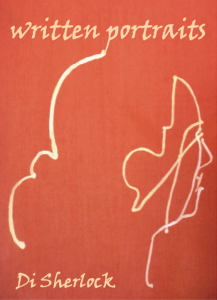On the 11th November 2020 we hosted an informal launch for Written Portraits, involving the ‘sitters’, patients, staff, friends, family, and many others interested to learn more about this collection. We were joined by a wonderful cast of actors and heard a selection of poems, ‘Vital Conversation‘ read by Clive Llewellyn, ‘Rewilding the Self’ from ‘The Art Class‘ read by Lin Sagovsky, ‘The Three Musketeers‘ read by Chris Barnes, and ‘Everyday Heroines‘ read by Susan Aderin.

Di Sherlock’s Written Portraits are words that perform: words that gather people so that each ‘portrait’ is formed through a mixed practice of assembly. Written Portraits was the outcome of Di Sherlock’s residency at Charing Cross Hospital and Maggie’s Centre West. Her writing involves three stages that are not really events but a series of interlinking processes, unpredictable in number, location and duration: conversation; composition; returning the poem to the ‘sitter’. With these activities Di gets the measure of an individual or group. She does not only write about people but includes their participation, through verbatim elements from conversations and through references and citations to other occasions, texts, and images. Editing is born from discussion and negotiation as they edit with different hands through a process that can go back and forth before both sitter and poet consider the portrait fits – a likeness or resemblance they both like. One sitter said it “took a while for that ‘portrait’ to percolate through, the ‘gift’ also requires acceptance” and this process involved showing their poem to family members and hearing their points of view: “I was reluctant to share the mirror you held up to me until now”, they said, “my father, a Scotsman, was fond of quoting Burns and there’s a few lines that stuck in my head: ‘O wad some Power the giftie gie us / To see oursels as ithers see us!’”
The launch event marked an ending for Written Portraits, the collection has now been presented to the public and its many mirrors shared. But a process of composition and comparison continues through an exchange of correspondences that connect, once more, to the practices of personalisation that have concerned the People Like You project. Written Portraits explores the ways that preference, need, desire, pleasure and recognition serve as grounds for judging people to be alike, i.e. grouped, comparable to each other. Each portrait contains a path into a life composed of others, insofar as it relates to and connects other people or things. The subjects of these poems are composite, multiply exposed, ‘fractal’ renderings of persons as sitters tell of themselves via mothers, fathers, or siblings, whether alive or dead, jobs and activities they do or do no longer, people they are or were or want to be. People and things to which they are alike, and they like, expressed through a portrait they are then asked to judge for its likeness and enjoyment. It is this composite understanding of the person, this view of portraits, that has intrigued and provoked our research group, especially when seen alongside developments in what is now commonly called ‘personalised’ or precision medicine.
Di Sherlock’s project has run in parallel to our interview and observational research in cancer services, where we have been learning about cancer care with patients and staff in clinical and non-clinical settings. Cancers have been the exemplar of a more personalised medicine that subtypes tumours based not only on their location, size, grading and staging, but also on their molecular characteristics. Tumours have thus been further differentiated and they are monitored with biochemical tracking techniques. Treatments have also been developed to target these subtypes, improving outcomes, and reducing harm to patients. Though patients may be told that their treatment is targeted and tailored, this is only possible because they are grouped or sorted into categories of patients ‘like’ or similar to them. Their ‘personalised’ medicine is forged through common characteristics of their cancers rather than biographical affinities – such as age, other health conditions – with others. Such combinations and conflations of need and similarity are provisional and promissory, since ‘people like you’ may like this treatment, or this, or that, until ‘you’ no longer coincides with the person you once were. You may no longer like your treatment; your cancer may no longer respond.
In this period of change, strain and crisis within UK health services we need the insight of counterfactual values provided by alternative forms of interaction, practice, and method, especially when we want to illuminate different qualities of relationship, persona, expression and value afforded to patients and staff in busy NHS services. What I have found so valuable about Di Sherlock’s work is how it highlights participative form, expectation, gift relations, and other practices constitutive of how people see themselves as persons. As a time-limited case study where liking and likeness coincide – at the point of agreement or fit between text and person – the collection moves by freeze-frames that contrast to other, iterative modes of medical personalisation.